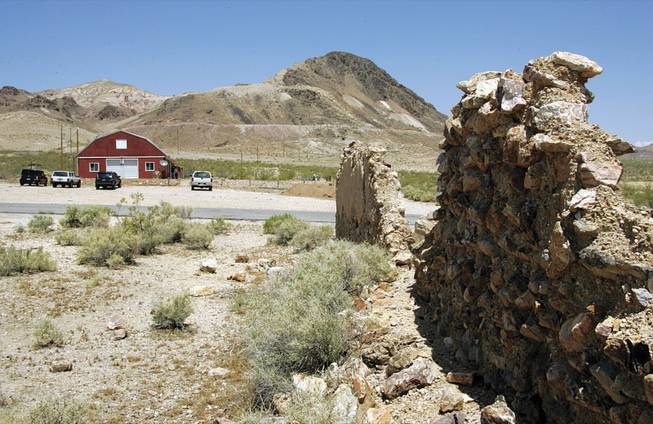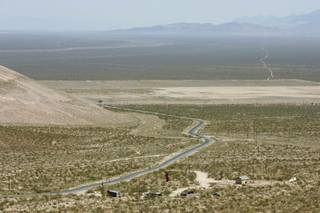
The ruins of a mining town building sit across the road from the Red Barn Art Center, part of the Goldwell Open Air Museum near the ghost town of Rhyolite, which is northwest of Las Vegas.
Sunday, June 7, 2009 | 2 a.m.
Sun Archives
Suzanne Hackett-Morgan sounded out of her mind five years ago when she proposed an artist residency near the ghost town of Rhyolite, just outside the gateway to Death Valley.
The elements are extreme. Cell phone service is random. The closest civilization is the town of Beatty, population 1,000.
Aside from the Goldwell Open Air Museum — an outdoor sculpture park left by Belgian artist Charles Albert Szukalski and friends — this part of Nevada was on nobody’s radar in terms of art.
Even more outlandish is that Hackett-Morgan and her husband, Charles Morgan, wanted the residency to take place in an old cinder block barn owned by the Barrick Bullfrog Mine — so dirty it would need to be gutted by a hazmat team.
The plan was ambitious, but so were they.
Goldwell Open Air Museum is now a member of Alliance of Artists Communities. Last year it was selected for a mentorship project with the New York State Artist Workspace Consortium.
Residencies and workshops are booked through the fall. Artists are paid $500 a week to work there with no expectation of producing anything. They stay in a Beatty home, purchased by the husband and wife team, and are free to focus on the creative process, uninterrupted.
“It’s really about giving people a chance to disconnect,” Hackett-Morgan says on a recent Saturday while cutting watermelon and setting out cheese and french bread in the back of the now tidy barn, cooled by a swamp cooler. Her husband and his friends install a security door. Two artists in residence work on their projects. Guests arrive sporadically for the day’s Open Studio.
“It’s also about being robust,” she says. “That, in itself, is part of the experience.”
The barn has printing and etching presses, a studio, gallery and office space, a satellite dish for Internet, and trucked-in water. Hackett-Morgan these days is most thrilled about the flushing toilet at the barn.
Artist Jeff Eisenberg, who came from San Francisco for a monthlong residency, had never been to Southern Nevada and didn’t know what to expect. “Next to an old gold mine, 12 miles to Yucca Mountain? I thought, ‘I gotta be here,’ ” he says. “I just came here to start responding.”
Eisenberg set aside his abstract digital environments, created on a computer then hand drawn onto mylar, during the day so he could experiment with other processes of built environments and human adaptation. In Rome, he saw centuries-old buildings topped with modern housing. While teaching in Wisconsin, he saw housing built from available materials “without recipe.” The Beatty artist home is made of two trailers stitched together and covered with a pueblo facade.
Henderson artist Keith Conley builds temporary sculptures used as photography props.
Made with PVC piping and colored plastic wrap, they resemble something created for a high school play or a low-budget, 1960s science-fiction movie. He photographs them in the open desert with a pinhole camera to create a somewhat obscure image.
Desert water towers or transient items left on the remote terrain inspired the project.
Conley had been creating three-dimensional images on his computer, then superimposing them on a backdrop. This gives him a chance to make it tangible. Tackling the project in Las Vegas was challenging. The props are cumbersome and open land is more scarce.
As for the rugged conditions, he says, “When you’re seeking a residency, you’re looking for something different. Being out of the comfort level is the whole point. Living in Las Vegas is not living in a desert. It’s living in a city.”
Hackett-Morgan and her husband have spent more than $100,000 of their own money on Goldwell, which includes the house in Beatty. Other funding comes mostly in state and federal grants, about $25,000 a year. They live in Las Vegas and drive 115 miles to Beatty a couple of times a month. Dedicated volunteers have helped with renovations and maintenance.
The couple have invested a good chunk of their lives into this. As to why, their only reason is to be able to provide a space for creative enrichment and for artists to experiment.
“It’s an opportunity to focus on what you want to do,” Charles Morgan says. “It’s not a super plush experience. It’s for someone who wants to come out here, be challenged, be transformed. The desert has been throughout history a place where transformation takes place. If your cell phone doesn’t work, that’s even better.”
The Beatty connection is not forgotten. Locals occasionally visit the barn. The Beatty High School culinary group one year catered “Albert’s Tarantella,” the barn’s annual arts festival in October. Artists-in-residence stop in at Beatty watering holes. A screening of a video on Szukalski’s work took place in one of them, the Sourdough Saloon, followed the next day with a panel discussion at the Beatty Community Center. A silent auction and dinner took place at a Beatty senior center. Hackett-Morgan gets her local news at the Sourdough, where Szukalski and friends hung out.
The artist rotations are noticed around town. Eve Laramee, chairwoman of interdisciplinary sculpture at the Maryland Institute College of Art, is now at the barn. Her specialty is art and science as it plays out in nature and culture. Next comes David Sanchez Burr, who is teaming up with Boston artist Craig Colorusso and Washington, D.C., artist Richard Vosseller to create a sound and visual art project.
Andrea Polli, a New Mexico digital media artist, will work on a weather-based project there in July with her husband Chuck Varga, a special effects artist.
In addition to Goldwell, Sanchez Burr and his partners will present their work at the Contemporary Arts Center in downtown Las Vegas. Polli and Varga will lead a neighborhood workshop at the Las Vegas Springs Preserve.
The programs are an effort to connect the Goldwell museum with Las Vegas. Hackett-Morgan aims to get more of Las Vegas to the barn. She’s been pleased with the large turnout at “Albert’s Tarantella.”
“We want people to come out and experience it because that’s why we do it,” she says.


Join the Discussion:
Check this out for a full explanation of our conversion to the LiveFyre commenting system and instructions on how to sign up for an account.
Full comments policy